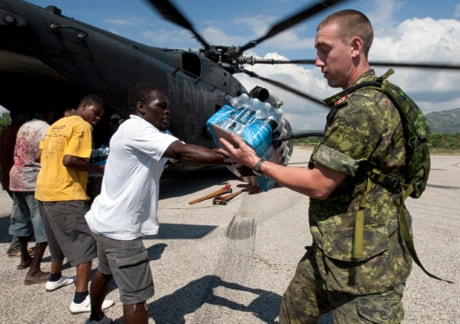JACMEL, Haiti — The coastal town of Jacmel is abuzz with activity as its tiny airport is being turned into a new point of entry for disaster relief, bypassing the supply bottleneck in the Haitian capital.
Jacmel — the backdrop for many of Gov. Gen. Michaelle Jean’s childhood memories in Haiti — is becoming a regional hub for the delivery of aid to earthquake victims along the southern coast of Haiti.
“Canada is starting to ferry troops in through Jacmel airport because the PaP (Port-au-Prince) airport is so congested,” Col. Bruce Ewing of the Canadian Forces said Wednesday.
“This is becoming an alternate way in for Canadians to move not just to Jacmel but throughout the country,” he said. “This is going to be a hub for Canadian Forces personnel.”
The airstrip is small, making it a challenge for large planes to land. Still, a seemingly endless stream of aircraft was using the airport.
Even a Canadian military Hercules transport landed with personnel and equipment for the Disaster Assistance Response Team, or DART, although it was apparently not fully loaded to ensure that it could safely use the undersized runway.
The airport is being upgraded. Canada is providing lighting, and the navy ship HMCS Halifax offshore has radar that can be used to guide incoming and outgoing flights. Other countries including the United States are involved in making the airport more usable for larger relief shipments.
“Once this air strip has been cleared for use,” Defence Minister Peter MacKay said in Ottawa, “the Canadian Forces will be in a position to control, manage the air space in the region of Haiti to allow our aircraft, Canadian Forces aircraft, to move in and out of Haiti and avoid the congestion that we’ve seen at the Port-au-Prince airport since the mission began.”
There is also an agreement to use a Jamaican airport as a transit point for Canadian military flights.
“With this air bridge we’ll be able to use the larger C-17 Globe Master aircraft to carry people, supplies and equipment between Canadian Forces base Trenton and Kingston, Jamaica,” MacKay said. “From there we’ll be able to use the C-130 Hercules aircraft for short haul trips into Haiti.”
Canadian soldiers have established a security presence at the Jacmel airport to keep back crowds of onlookers.
Advance elements of DART have rented a plot of land about 20 minutes’ drive from the airport as the site for a permanent base of operations. The plan is for DART to operate giant water-purification units to provide potable water in the town.
Canadian doctors have started to treat local people in Jacmel. Those who received first aid after the quake last week are now in need of care for secondary infections and illnesses.
Some of the Canadian personnel on the ground came via helicopter from the Halifax offshore; others by helicopter and air transport.
Jacmel is about 35 kilometres from Port-au-Prince, but a mountain range lies between the two communities and the road is heavily damaged in places, impeding the movement of large vehicles.
Amid all the Canadian activities, the local people appeared curious but in the dark.
Edwin Zenny, mayor of the Jacmel area, said: “We at the mayor’s office will work with them (the Canadians) but, to be honest, I don’t know exactly what they will do. They haven’t told us what they are going to do.”
Lesly Percil, a radio station host and head of a local association of journalists, said Jacmel’s people have no idea what’s going on. “We have no way of knowing what the Canadians are doing.”
Jacmel city has between 50,000 and 70,000 people; the greater Jacmel region has a total population of 120,000.
The mayor said Jacmel has buried an estimated 300 victims of the Jan. 12 earthquake, but casualties are expected to go higher. A church collapsed with 80 people believed inside, and the digging for survivors or bodies had only just started. An estimated 2,000 to 3,000 people were injured.
The situation appeared not as grave as the massive death and destruction in Port-au-Prince. Relief goods have not yet been distributed locally; they were put in storage.
“I haven’t seen any desperation, at least not yet,” said Nick Mangine of the local aid group Joy and Hope. “I think it’s going to change pretty soon though” as food in the markets run out.
Mangine said local aid groups would like the Canadians to have better control of the situation before aid is handed out, so as to avoid any chaotic scenes.
“If we start distributing here, it’s going all to hell,” he said.
